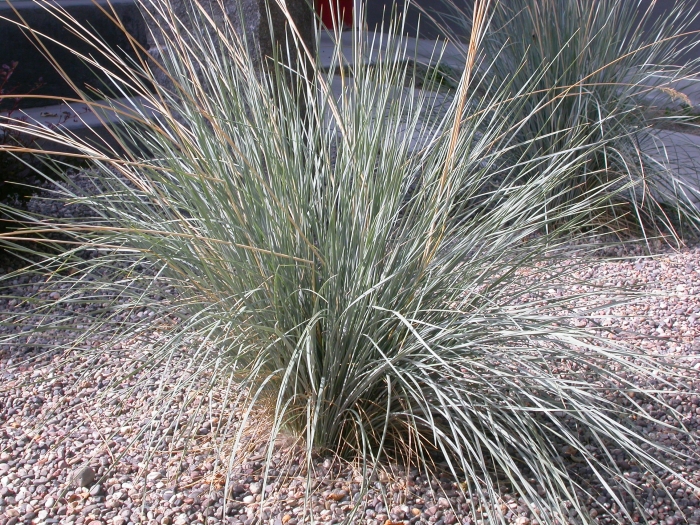Blue Oat Grass
(Helictotrichon sempervirens)
Blue Oat Grass (Helictotrichon sempervirens)
/
/

Matt Lavin from Bozeman, Montana, USA
CC BY-SA 2.0
Image By:
Matt Lavin from Bozeman, Montana, USA
Recorded By:
Copyright:
CC BY-SA 2.0
Copyright Notice:
Photo by: Matt Lavin from Bozeman, Montana, USA | License Type: CC BY-SA 2.0 | License URL: https://creativecommons.org/licenses/by-sa/2.0 | Uploader: File Upload Bot (Magnus Manske) | Publisher: Wikimedia Commons | Title: Helictotrichon_sempervirens_(3912089218).jpg | Notes: Uploaded own work with UploadWizard |




















Estimated Native Range
Summary
Helictotrichon sempervirens, commonly known as Blue Oat Grass, is an evergreen perennial grass native to dry, open grasslands of central and southwest Europe. It typically grows in an arching shape, reaching up to 140 cm (55 in) tall and 60 cm (24 in) wide. The foliage is a striking steel blue to blue-green color, providing year-round interest in the garden. Blue Oat Grass blooms with subtle, pale blue-green flowers from May to August, which add a delicate texture to its appearance. The inflorescences are not particularly showy but contribute to the plant’s overall ornamental value.
Blue Oat Grass is valued for its drought tolerance and its ability to maintain its color and form throughout the year. It is commonly used in garden design and landscaping as an accent plant, in borders, or as a ground cover. It thrives in full sun and requires well-drained soil, tolerating a range of soil types from clay to loam. While it prefers low to medium amounts of water, it can endure periods of drought once established. This grass is generally low maintenance, but it can benefit from being cut back in late winter to early spring to remove old foliage and encourage fresh growth. It is not known for having serious disease or pest problems, but in wet conditions, it may suffer from rust or root rot.CC BY-SA 4.0
Blue Oat Grass is valued for its drought tolerance and its ability to maintain its color and form throughout the year. It is commonly used in garden design and landscaping as an accent plant, in borders, or as a ground cover. It thrives in full sun and requires well-drained soil, tolerating a range of soil types from clay to loam. While it prefers low to medium amounts of water, it can endure periods of drought once established. This grass is generally low maintenance, but it can benefit from being cut back in late winter to early spring to remove old foliage and encourage fresh growth. It is not known for having serious disease or pest problems, but in wet conditions, it may suffer from rust or root rot.CC BY-SA 4.0
Plant Description
- Plant Type: Grass
- Height: 2-3 feet
- Width: 2-2.5 feet
- Growth Rate: Moderate
- Flower Color: N/A
- Flowering Season: Summer
- Leaf Retention: Evergreen
Growth Requirements
- Sun: Full Sun
- Water: Low, Medium
- Drainage: Medium
Common Uses
Bank Stabilization, Border Plant, Deer Resistant, Drought Tolerant, Groundcover, Low Maintenance, Potted Plant, Rabbit Resistant, Rock Garden, Salt Tolerant, Street Planting
Natural Habitat
Dry, open grasslands of central and southwest Europe
Other Names
Common Names: Silverhavre
Scientific Names: , Helictotrichon sempervirens, Avena sempervirens, Helictotrichon sempervirens var. sempervirens, Avena striata, Avena notarisii, Avena fallax, Trisetum striatum, Avena sesquitertia, Arrhenatherum sempervirens
GBIF Accepted Name: Helictotrichon sempervirens (Vill.) Pilg.